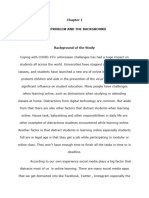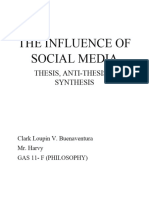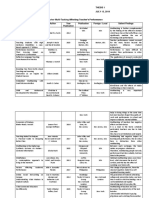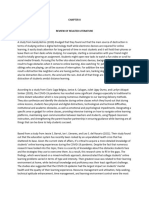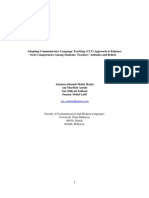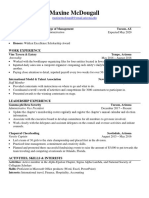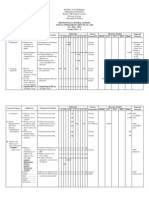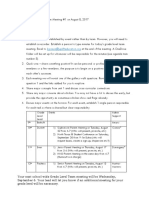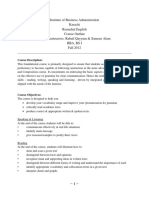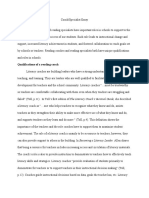Logan Boxdorfer
Dallas College
14 March 2021
Effect of Multitasking
Multitasking has evolved to become an essential issue in modern society.
Multitasking has evolved in every life aspect, becoming integrated in every way possible to
aspects in modern-day society. Multitasking has become related to technology that has
imparted an important aspect of people’s lives. Multitasking can be viewed as the
performance of a variety of different and related things at the same time. Technology has
even made it easier to multitask on activities in different geographical locations from the
comfort of one’s home.
The aspect of multitasking happens naturally without the individual even noticing that
he/ she is multitasking. Multitasking has made it easier to go through daily activities faster
and in a convenient way. A person may multitask while doing house activities such as
washing dishes and listening to music. One might be traveling while at the same time reading
a novel. Multitasking makes it easy to get involved in different activities at a go. Students
nowadays are pinned down with packed schedules and numerous responsibilities that call for
them to think creatively about and do multiple tasks. However, as much as multitasking can
be considered a blessing, it degrades young generations’ ability to think clearly, communicate
effectively, and focus.
Effects of Media Multitasking on Students
� The article “Multitasking State of Mind,” by Joanne Simpson, talks on how
technology has turned out to become a distraction tool for the student rather than its intended
purpose of helping people out. I agree that distraction in multitasking has led to students
becoming less interested, bringing about a lack of communication skills, which often leads to
them becoming less productive in classes. Simpson faults technology as to why most students
are getting accustomed to using the internet to help them out in their classwork. “Students are
now becoming more zoned out and less able to complete the assignments while in the
classroom” (Simpson). She faults this to technological advances as students are aware that
the internet and technology platforms present will help them later finish on their projects and
assignments given in class at just a mere cost.
She argues that students’ minds while in class, are used to multitasking. Simpson
states that a student might be in the classroom physically with their minds completely out of
the class. The rise of social media platforms due to technological advances has made student
life more accustomed to the public impression the student has on his peers and how well they
are dressed. This state of mind makes students think more about their social life more than
their purpose in school, study (J. Lee). Simpson argues that the mental habit of driving one’s
attention into many small activities has caused a significant number of implications into the
way young people learn, reason, socialize and do other creative things. Simpson discusses the
downside of multitasking and its detrimental effects on students.
Joanne Simpson states that students have lost the ability to stay focused and
effectively concentrate on what’s in front of them due to divided concentration of the various
aspects they have to deal with in life. Students are faced with a crisis in the state of mind.
However, multitasking offers several benefits to students as it enables them to multitask and
� complete everyday tasks successfully effectively. This causes stress in today’s younger
generation and can often be a major cause of failure and poor school test performance
(Simpson).
Multitasking presents the aspect of having divided attention on different activities.
Students only need to concentrate on the classwork and what is being taught while in the
classroom. Students face a lot of pressure both from the school and at home. Failure to
concentrate on what’s being taught in the class causes poor grades in examination tests as the
students’ attention and concentration were somewhere else when the aspects were being
taught (W. Jeffrey).
Technology
Technology has become a distraction and not just to students but the whole
population. Technology has exerted a lot of pressure and majorly on the younger generation,
especially through social media platforms. Students have lost the focus of their personal
growth, focusing on what the social platforms present. Social platforms have brought a sense
of popularity amongst the students other than uniqueness; most students following what their
peers do on these platforms instead of standing out. Losing focus on personal growth and
development has significant and disastrous consequences on a student’s life (L. Burak).
Losing focus on classwork leads to poor performance and grades in schools in the present
society.
Technology has also brought about the aspect of cheating by students on classwork.
Students can now easily navigate about their activities by mandating other people to write
their assignments for pay. The multitasking effect has also enhanced this as students try to
� finish up on all their tasks resulting in them paying for other activities to be done on their
behalf to enable them to beat the deadline.
Conclusion
Multitasking is essential in life as it aids in the completion of many tasks at a go.
However, student multitasking is a lead cause for poor performances and communication
amongst many institutions (Aagard, Media Multitasking, attention, and distraction: a critical
discussion). Students should only focus their attention on schoolwork when in the classroom,
giving the required attention in the classroom. Planning of activities should be done in a way
that no event overlaps with the other. The effect of multitasking school-based activities with
technology can interfere with the learning process. Research shows a clear performance
decrement when trying to attend to two tasks at the same time. Multitasking presents both
educational opportunities and learning problems; therefore, multitasking should be effectively
managed.
� WORKS CITED
Ellis, Y., Daniels, B. "The effect of multitasking on the grade performance of business
students." Research in Higher Education Journal (2010). <https://
www.renevanmaarsseveen.nl/wpcontent/uploads/overig2/
effect%20multitasking%20on%20students.pdf>
Aagaard, J., 2014. Media multitasking, attention, and distraction: a critical discussion.
Phenomenology and the Cognitive Sciences, [online] 14(4), pp.885-896. Available at:
<https://link.springer.com/article/10.1007/s11097-014-9375-x>.
Burak, Lydia. "Multitasking In The University Classroom". International Journal For The
Scholarship Of Teaching And Learning, vol 6, no. 2, 2012. Georgia Southern
University, doi:10.20429/ijsotl.2012.060208.
Wammes, Jeffrey D. et al. "Disengagement During Lectures: Media Multitasking And Mind
Wandering
In University Classrooms". Computers & Education, vol 132, 2019, pp.
76-89. Elsevier BV, doi:10.1016/j.compedu.2018.12.007.
Lee, Jennifer et al. "The Impact Of Media Multitasking On Learning". Learning, Media And
Technology, vol 37, no. 1, 2011, pp. 94-104. Informa UK Limited,
doi:10.1080/17439884.2010.537664.


















